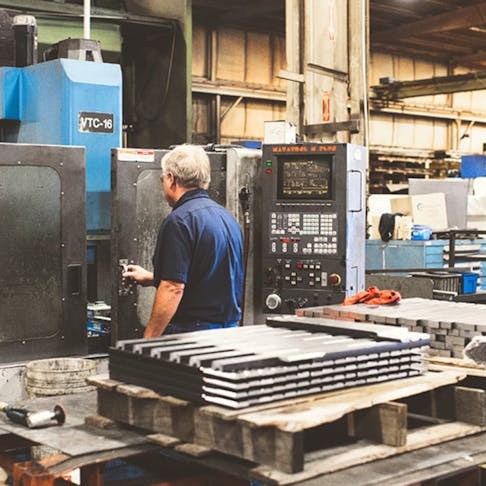For those of us working in U.S. manufacturing, right now is a chance to dream big about our industry, our companies, our employees and ourselves. Given how fast our industry is changing, this aspirational impulse isn’t likely to be a fool’s errand, either. The accelerating pace of tech and its influence on everything from online CNC machining to supply chain management means moving the needle of reality fast is a given. Those manufacturers who manage to adjust to tech’s breakneck pace the quickest and most meaningfully stand to achieve the most.
Here, then, are three and a half ways to push U.S. manufacturing over the top in terms of revenue, market share, cost savings and innovation.
1) Figure out what to do with data
Long touted as a sort of one-size-fits-all amorphous savior to any organization in need of “increased efficiency” and “greater productivity,” wrangling data for competitive advantage has worked really well for some companies. Most manufacturers, however, have found it rather difficult to leverage.
The reasons for the difficulty are many. There’s the sheer — and exponentially increasing volume — of the stuff, the fact that not all data is created equal, the lack of available talent able to make sense of it (let alone apply it), the widely dispersed nature of most manufacturers’ supply chains and some rather persistent industry blind spots. For most manufacturers, just trying to think about how to utilize a technology like big data is enough to make heads spin. Forget about actually utilizing it.
There’s a way out of the mess. As Jack Levis, Senior Director of Process Management at UPS, put it in a keynote address at the SAS Analytics conference back in 2015, “I don’t have a single big data problem. I have business projects … big data is a how. It’s not a what.”
When you think of ways to improve your business, the promise of big data becomes a lot more clear. Take the amount of time wasted during the traditional RFQ process for instance. What if you could not only speed up sourcing but achieve a more reliable path to fair pricing at the same time?
The data to pull off such a stunt exists, and the application does, too. Here at Xometry, we gather machining, 3D printing and injection molding data and apply it so effectively we not only circumvent the RFQ process and deliver fair-market, data-driven pricing instantly, we often move companies from quoting to production in a single business day.
So, rather than chasing after big data in hopes of discovering where you might be able to use it, identify those business processes that could benefit from an overhaul and apply it there. In-person supplier vetting, the RFQ process, prototyping as a separate and siloed manufacturing consideration from running production — in the light of big data, these sacred pillars of U.S. manufacturing are giant wastes of time that keep you from getting to market ahead of the global competition.
2) Rethink inventory and warehousing
The cost of storing goods is something every company selling a physical product would like to reduce. From retailers to OEMs to machine shops and publishing houses, every piece of overstock or just-in-case inventory sitting on a shelf isn’t just a product to have on-hand in case a customer needs it in the future. It’s also a product a customer may never buy. Even among those companies for whom warehousing combined with eCommerce is the working business model — Amazon being the clear winner in this department — reducing the costs of warehousing goods is still paramount.
That’s why almost every company is getting increasingly creative to lower costs. From the implementation of lean principles and continuous improvement among warehouse staff to increased automation and robotics, cutting costs on inventory and storage is big business. But what if the answer to drastically lowering costs isn’t inside a more efficient warehouse at all? What if manufacturers’ approach to inventory ceased to be a question of how to best cut costs and instead became a question of how to best bypass the traditional notion of inventory itself?
If there was ever a time to rethink your approach to inventory and warehousing, it’s now. The explosion of inexpensive cloud storage solutions that came online in 2016 makes a digitized approach to warehousing possible in a way that is completely new.
Imagine a virtual warehouse that stored all your digital part files. Now, imagine a network of suppliers large enough to guarantee every part file you had stored in the cloud could be machined or printed on-demand whenever a customer needed it. For manufacturers with access to a digital and distributed supply base, this approach to inventory and warehousing is already possible.
With Xometry, every one of our customers has access to free and secure cloud-based storage in our parts library. Because we also have access to the largest CNC machining, 3D printing and injection molding supply network in the country, we can always turn those files into real parts, whether you need 2 3D printed prototypes, 200 CNC milled parts or 200,000 injection molded widgets. It doesn’t matter if you’re still running production or that you’re ready to move into low-volume aftermarket batches, the potential to save money storing parts as digital files rather than actual parts can completely change your bottom line.
3) Get back to R&D
Outsourcing our CNC machining, garment construction, electronics assemblies, biotech and the like has certainly saved a lot of U.S. companies a lot of money. It also cost a lot of U.S. shops, factories and people a lot of jobs. While the resulting breakdown in trust between suppliers, workers and manufacturers shows signs of slow repair, the hit manufacturing took in terms of R&D and innovation is still not fully understood or appreciated.
According to an article in the Harvard Business Review titled, “Does America Really Need Manufacturing,” U.S. companies’ obsession with cutting costs in the short-term has harmed our long-term prospects for innovation. Being that innovation is a key driver of our country’s economy, that’s not good news.
According to the article’s authors, Gary Pisano and Willy Shih, the relationship between inventing and developing a product and manufacturing it is more tightly interwoven than originally believed. By outsourcing the making of our goods, we’ve actually outsourced the potential to innovate and develop outstanding, groundbreaking products as well.
How? Deep knowledge — the kind that yields the adventurous insight necessary for innovation — comes from making, not just designing. When U.S. manufacturing decided en masse to ship a lot of its making offshore, it watered down the vital feedback loop that exists when designing and making are carried out in tandem. Regardless of whether “in tandem” means in the exact same location or just in the same time zone, manufacturing where you’re designing allows for a back and forth in communication that creates process and product adjustments that can push R&D forward.
3.5) Reshore Your manufacturing
To get back to good R&D work, then, it’s essential to reshore your manufacturing. Not only will doing so shorten your supply chain and allow for more effective communication, but it will strengthen our Industrial Commons, raising the whole country’s tide of innovation and lifting all boats in the process.
Pushing U.S. Manufacturing over the top won’t happen without concentrated effort. Resolve to do things differently and better by embracing the amazing tech and suppliers available right here in the U.S.A.
Xometry is committed to revitalizing American manufacturing by connecting you with over 2,300 machine shops in 49 states across the country. Instantly access their production capacity through the Xometry Instant Quoting Engine℠.

